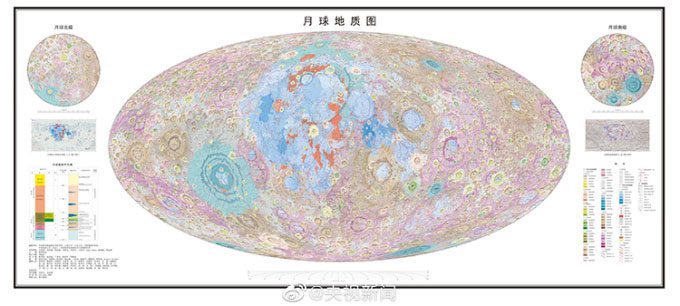China Unveils New Lunar Topographic Map at a Scale of 1:2,500,000, Revealing Various Types of Rocks and Impact Craters.
Scientists from the Institute of Geochemistry under the Chinese Academy of Sciences (CAS), along with several other organizations such as the Chinese Academy of Geological Sciences, China University of Geosciences, and Shandong University, have created a high-resolution topographic map of the Moon based on data from the Chang’e lunar exploration project and various research findings from international institutions. The new map was published in the journal Science Bulletin on May 30.

China’s lunar topographic map at a scale of 1:2,500,000. (Image: Institute of Geochemistry, Chinese Academy of Sciences (CAS)).
Chinese researchers have introduced this as the most detailed lunar map to date at a scale of 1:2,500,000, surpassing the lunar surface map published by the Astrogeology Science Center of the U.S. Geological Survey (USGS) in 2020. This previous map was at a scale of 1:5,000,000, created by the Astrogeology Science Center in collaboration with NASA and the Planetary and Lunar Institute.
The new map includes 12,341 impact craters, 81 basins, 17 types of rocks, and 14 structural types, providing rich information about the geology and evolution of the Moon. It is expected to make significant contributions to scientific research, exploration, and the selection of landing sites on the Moon.
In recent years, China has successfully carried out several lunar exploration missions. In January 2019, the Chang’e 4 lander touched down on the far side of the Moon, becoming the first spacecraft to land in this region, which is not visible from Earth. In December 2020, the Chang’e 5 mission returned to Earth, bringing back valuable samples of lunar soil and rocks.
China has also marked its presence on the Moon. At least 8 structures near the landing site of Chang’e 5 were named after Chinese scientists and geographical locations in May 2021. The International Astronomical Union (IAU), based in Paris, approved these 8 Chinese names for structures in the vicinity of the Chang’e 5 landing site. The total number of geographical structures on the Moon currently bearing Chinese names is 35. Additionally, the country plans to send a crewed mission to the Moon around 2030.





















































